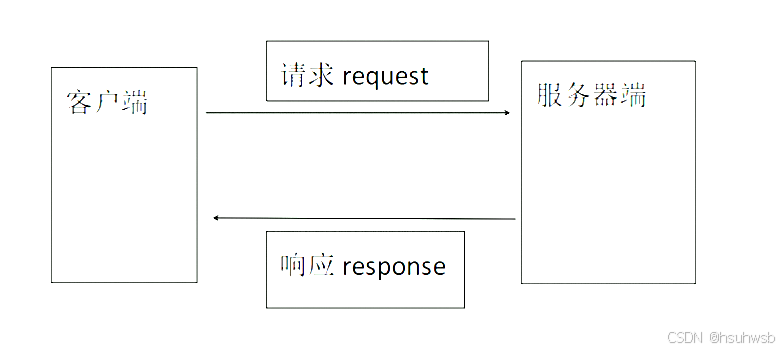go web基础
HTTP
-
Http:无状态协议,是互联网中使用Http实现计算机和计算机之间的请求和响应
-
Http使用纯文本方式发送和接收协议数据,不需要借助专门工具进行分析就可以知道协议中数据
-
-
Http报文(message)组成部分
-
请求行(request-line)
-
请求头(head)
-
请求体(body)
-
响应头
-
响应体
-
-
HTTP1.1实现了多种请求方式
-
GET:向服务器请求资源地址
-
HEAD:只要响应头
-
POST:直接返回请求内容
-
PUT:创建资源
-
DELETE:删除资源
-
TRACE:返回请求本身
-
OPTIONS:返回服务器支持HTTP方法列表
-
CONNECT:建立网络连接
-
PATCH:修改资源
-
-
软件模型
-
B/S结构,客户端浏览器/服务器,客户端是运行在浏览器中
-
C/S结构,客户端/服务器,客户端时独立的软件
-
-
HTTP POST简易模型图

GO语言对HTTP支持
-
在Golang的net/http包提供了HTTP客户端和服务端的实现
-
HandleFunc()可以设置函数的请求路径
// HandleFunc registers the handler function for the given pattern
// in the DefaultServeMux.
// The documentation for ServeMux explains how patterns are matched.
func HandleFunc(pattern string,handler func(ResponseWriter,*Request)) {
DefaultServeMux.HandleFunc(pattern,handler)
}-
ListenAndServe实现了监听服务
// ListenAndServe always returns a non-nil error.
func ListenAndServe(addr string, handler Handler) error {
server := &Server{Addr: addr, Handler: handler}
return server.ListenAndServe()
}-
代码实现
package main
import (
"fmt"
"net/http"
)
func welcome(res http.ResponseWriter, req *http.Request) {
res.Header().Set("Content-Type", "text/html;charset=utf-8")
fmt.Fprintln(res, "Hello world Golang Web <b>Prisoner<b/>")
}
func main() {
http.HandleFunc("/", welcome)
http.ListenAndServe("localhost:8081", nil)
}
单控制器
-
在Golang的net/http包下有ServeMux实现了Front设计模式的Front窗口,ServeMux负责接收请求并把请求分发给处理器(Handler)
-
http.ServeMux实现了Handler接口
type Handle interface {
ServeHTTP(ResponseWriter, *Request)
}
type ServeMux struct {
mu sync.RWMutex
m map[string]muxEntry
hosts bool // whether any patterns contain hostnames
}
func (mux *ServeMux) ServeHTTP(w ResponseWriter,r *Request) {
if r.RequestURI == "*" {
if r.ProtoAtLeast(1,1) {
w.Header().Set("Connection","close")
}
w.WriteHeader(StatusBadRequest)
return
}
h,_ := mux.Handler(r)
h.ServeHTTP(w,r)
}-
自定义结构体,实现Handler接口后,这个结构体就属于一个处理器,可以处理全部请求
-
无论在浏览器中输入的资源地址是i什么,都可以访问ServeHTTP
-
-
代码实现
package main import ( "fmt" "net/http" ) type MyHandler struct { } func (mh *MyHandler) ServeHTTP(res http.ResponseWriter, req *http.Request) { fmt.Fprintln(res, "输出内容") } func main() { myhandler := MyHandler{} server := http.Server{ Addr: "localhost:8090", Handler: &myhandler, } server.ListenAndServe() }
多控制器
-
在实际开发中大部分情况是不应该只有一个控制器的,不同的请求应该交给不同的处理单元。在Golang中支持两种多处理方式
-
多个处理器(Handler)
-
多个处理函数(HandleFunc)
-
-
使用多处理器
-
使用http.Handle把不同的URL绑定到不同的处理器
-
在浏览器中输入http://localhost:8090/myhandle或http://localhost:8090/myother可以访问两个处理器方法,但是其他URL会出现404(资源未找到)页面
-
-
代码实现
package main import ( "net/http" ) type MyHandler struct { } type MyHandle struct { } func (mh *MyHandle) ServeHTTP(res http.ResponseWriter, req *http.Request) { res.Write([]byte("多处理器-MyHandle返回的数据!!!")) } func (mh *MyHandler) ServeHTTP(res http.ResponseWriter, req *http.Request) { res.Write([]byte("多处理器-MyHandler返回的数据!!!")) } func main() { myhandler := MyHandler{} myhandle := MyHandle{} server := http.Server{ Addr: "localhost:8090", } http.Handle("/myhandler", &myhandler) http.Handle("/myhandle", &myhandle) server.ListenAndServe() }
多函数
-
多函数方式要比多处理器方式简便们直接把资源路径与函数绑定
-
代码实现
package main import "net/http" func MyHandle(res http.ResponseWriter, req *http.Request) { res.Write([]byte("多函数-MyHandle返回的数据!!!")) } func MyHandler(res http.ResponseWriter, req *http.Request) { res.Write([]byte("多函数-MyHandler返回的数据!!!")) } func main() { server := http.Server{Addr: "localhost:8090"} http.HandleFunc("/MyHandle", MyHandle) http.HandleFunc("/MyHandler", MyHandler) server.ListenAndServe() }
获取请求头
-
在浏览器地址栏中输入下面信息,这属于http请求的get方式,请求携带两个参数
-
代码实现
package main import ( "fmt" "net/http" "strings" ) func param(res http.ResponseWriter, req *http.Request) { header := req.Header fmt.Fprintln(res, header) fmt.Fprintln(res, header["Accept-Encoding"]) fmt.Fprintln(res, len(header["Accept-Encoding"])) for _, n := range strings.Split(header["Accept-Encoding"][0], ",") { fmt.Fprintln(res, strings.TrimSpace(n)) } } func main() { server := http.Server{Addr: "localhost:8090"} http.HandleFunc("/param", param) server.ListenAndServe() }
获取请求参数
-
请求参数可以一次全部获取也可以按照名称获取
-
代码实现
package main import ( "fmt" "net/http" "strings" ) func param(res http.ResponseWriter, req *http.Request) { header := req.Header fmt.Fprintln(res, header) fmt.Fprintln(res, header["Accept-Encoding"]) fmt.Fprintln(res, len(header["Accept-Encoding"])) for _, n := range strings.Split(header["Accept-Encoding"][0], ",") { fmt.Fprintln(res, strings.TrimSpace(n)) } } func main() { server := http.Server{Addr: "localhost:8090"} http.HandleFunc("/param", param) server.ListenAndServe() }





















 被折叠的 条评论
为什么被折叠?
被折叠的 条评论
为什么被折叠?








